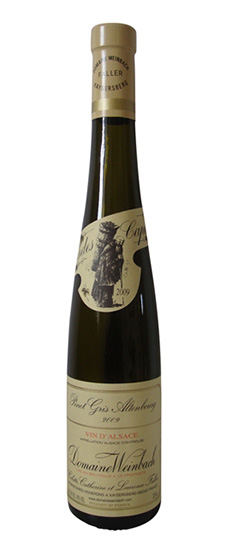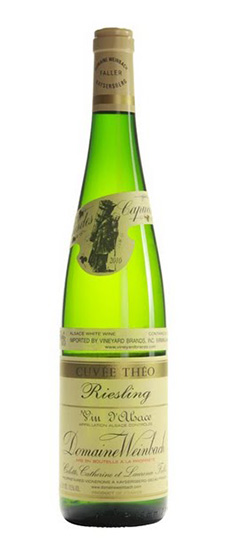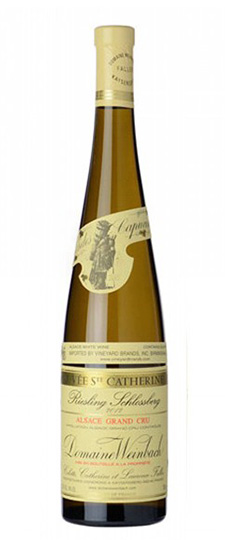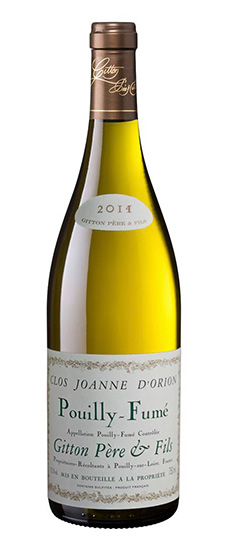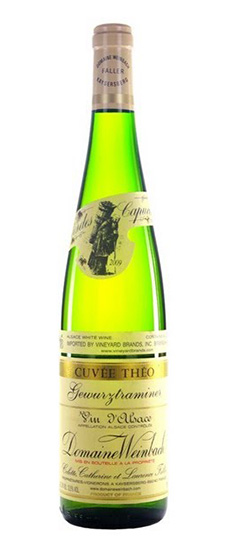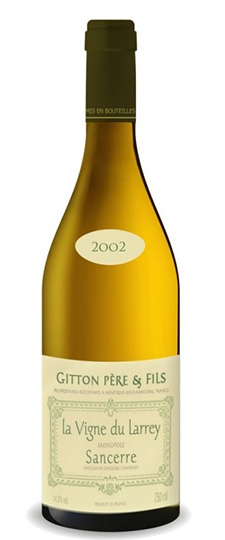Wine Score
Vinous 91+ points
Bright golden straw-yellow. The complex nose combines peach, musky herbs and butter; then similar flavors in the mouth. Sweet and concentrated, but with fresh acidity nicely framing and extending the fruit on the long back end. Not yet complex, but I think it will reward patience. Made from grapes grown in the Clos, a piece of Schlossberg and the young vines (eight years old) of the Marckrain Grand Cru, this is a must-try with mushroom risotto. (Mar 2017)
Wine Spectator 91 points
Fine and creamy, this light- to medium-bodied white offers a sense of finesse, layering bright acidity, spicy minerality and flavors star fruit, peach skin, orange blossom, candied ginger and smoke. Drink now through 2025. 440 cases made. -AN (Oct 31 2016)
Grape Variety
Pinot Gris Wine
Pinot Gris is a white-wine grape originally from the vineyards of Burgundy, but now found in wine regions all over the world. When produced in the pale, light style popularized in late 20th-Century Italy, the variety and its wines are typically referred to by the Italian name Pinot Grigio.
One of the more famous members of the extended Pinot family of grape varieties, Pinot Gris is a pink-skinned mutation of Pinot Noir. The two varieties are indistinguishable in the vineyard right up until veraison, when Pinot Gris berries take on their distinctive array of colors; anything from orange-pink to pale, dusty purple. The adjective gris is French for “gray”, and refers to the dusty, light-gray sheen the grapes often take on. Although possibly confusing to English speakers, this convention is widely used in Europe, notably in Italian (grigio), German (grauer), Slovenian (sivi) and Czech (sede).
Pinot Gris grapes
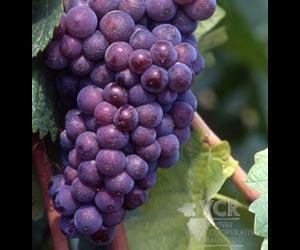 Although sometimes used as a blending component, Pinot Gris is most commonly produced as a varietal wine. Flavors and aromas vary greatly from region to region and from style to style, but commonly feature notes of pears, apples, stonefruit, sweet spices and even a hint of smoke or wet wool. Most winemakers avoid obvious oak character in their Pinot Gris, but some use older barrels (which leave less oak flavor in the wine) for fermentation. For weightier, more complex styles of Pinot Gris, lees contact and partial malolactic fermentation are commonly used. Sweet late-harvest versions wines are common.
Although sometimes used as a blending component, Pinot Gris is most commonly produced as a varietal wine. Flavors and aromas vary greatly from region to region and from style to style, but commonly feature notes of pears, apples, stonefruit, sweet spices and even a hint of smoke or wet wool. Most winemakers avoid obvious oak character in their Pinot Gris, but some use older barrels (which leave less oak flavor in the wine) for fermentation. For weightier, more complex styles of Pinot Gris, lees contact and partial malolactic fermentation are commonly used. Sweet late-harvest versions wines are common.
Pinot Gris grapes are naturally low in acidity and high in sugars, so the finest Pinot Gris wines come from the world’s cooler viticultural regions; those from warmer climates tend to lack acidity and structure and can be overbearingly alcoholic. Europe’s showcase examples come from vineyards on either side of the Rhine river, from Baden and Pfalz in Germany and, particularly, Alsace in France. In these regions, the wines are made in varying levels of sweetness, from bone dry to lusciously sweet; a Pinot Gris Selection de Grains Nobles from Alsace is one of the sweetest, most intensely flavored wines on earth.
In Alsace, Pinot Gris was known for many centuries as Tokay or Tokay d’Alsace. However, in 2007 the European Union outlawed use of that name in Alsace, in order to prevent confusion with Hungary’s prestigious Tokaji wines.
Of the New World wine regions, the variety is doing well in the United States (most notably Oregon but also Washington and California) and New Zealand. New World producers have recognized and respected the distinction between the Pinot Gris and Pinot Grigio styles, and typically label their wines accordingly (lighter, drier versions as Pinot Grigio, while sweeter or richer styles as Pinot Gris).
For more information on Pinot Gris’ lighter, crisper alter ego, see Pinot Grigio.
Synonyms include: Pinot Grigio, Rulander, Grauburgunder, Grauer Burgunder, Grauer Riesling, Grauklevner, Malvoisie, Fromenteau Gris, Pinot Beurot, Auvernat Gris, Auxerrois Gris, Tokay d’Alsace (prior to 2007), Szurkebarat, Sivi Pinot.
Food matches for Pinot Gris include:
- Insalata di bresaola (air-cured beef salad)
- Salt and pepper squid
- Pulled pork with fennel and apple slaw
Region
Clos des Capucins Wine
Clos des Capucins is one of the most respected vineyards in Alsace, with a long and distinguished history. The vineyard is a monopole of Domaine Weinbach, established in 1612 by the Capucin monks who built the clos. The Weinbach title was chosen by the monks for its symbolism. It means ‘The Stream of Wine’, a reference to the brook flowing through the estate en route from the lower Vosges to the Rhine.
Domaine Weinbach – and therefore the Clos des Capucins – is now owned by the Faller family. They acquired it in 1898 after it was seized as national property during the French Revolution. The clos has remained the domaine’s headquarters and flagship vineyard.
Clos des Capucins
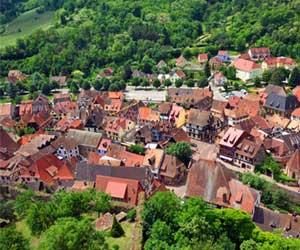 Kaysersberg, home to the Clos des Capucins
Kaysersberg, home to the Clos des Capucins
Not all of Domaine Weinbach’s wines come from the Clos des Capucins (it covers only 12 acres/5ha). The domaine also has vineyards within the Furstentum and Mambourg Grand Crus, just to the east, and in the Schlossberg Grand Cru on the hillside immediately above the clos. The Cuvee Theo wines, named after Theo Faller, are Riesling and Gewurztraminer wines produced exclusively from Clos des Capucins grapes.
The first references to the Capucin monastery here date back to the ninth century, although it is uncertain whether wine grapes were being grown in the clos as long ago as that. Whenever the first cuvees were made, the Clos des Capucins has secured a place in Alsace’s wine history.
Producer Notes
About Domaine Weinbach
Domaine Weinbach is a leading wine estate in the Alsace region. It is named after the “wine brook”, a small stream that runs through the main property, which is a former monastery near Kayserberg. The estate is known for its wines made at varying levels of sweetness from Riesling, Pinot Gris, Pinot Blanc, Sylvaner, Gewürztraminer and Muscat.
Domaine Weinbach
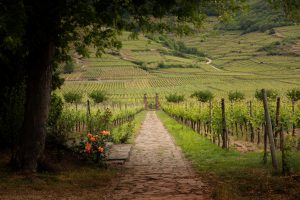 Unusually for the region, Weinbach only uses estate-grown grapes. It has holdings in four nearby Grand Cru vineyards on the slopes of the Weisbach Valley – Schlossberg, Furstentum, Mambourg and Marckgrain. Weinbach also owns the famous 5-hectare (12-acre) monopole, Le Clos des Capucins, which surrounds the cellars just below Schlossberg, and the Altenbourg vineyard adjacent to Furstentum.
Unusually for the region, Weinbach only uses estate-grown grapes. It has holdings in four nearby Grand Cru vineyards on the slopes of the Weisbach Valley – Schlossberg, Furstentum, Mambourg and Marckgrain. Weinbach also owns the famous 5-hectare (12-acre) monopole, Le Clos des Capucins, which surrounds the cellars just below Schlossberg, and the Altenbourg vineyard adjacent to Furstentum.
All of the estate’s 28ha (69 acres) of vineyards have been farmed biodynamically since 2005 and are certified by Ecocert and Demeter. After a gentle, gradual pressing, the juice is slowly fermented in old oak vats using indigenous yeasts.
For several decades the estate was run by Colette Faller and her daughters, winemaker Laurence and sales director Catherine. Laurence died tragically young from a heart attack in 2014, and her mother passed away the following year. Catherine Faller now runs the estate with her sons.

